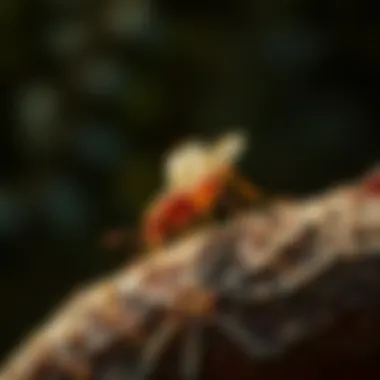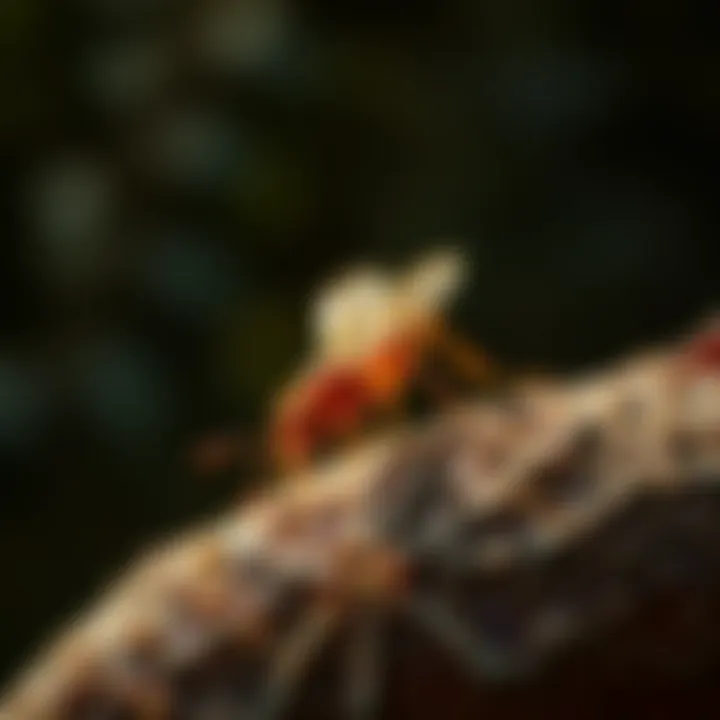Bayer Termite Medicine: Comprehensive Overview


Intro
When it comes to keeping your home safe from termites, understanding the problem and knowing how to tackle it is essential. Bayer termite medicine is often on the radar for pest control, promising effective solutions for one of the most persistent challenges in home maintenance. As we delve into this topic, we’ll explore various aspects of termite management, taking a closer look at how Bayer has carved its niche in this industry.
Understanding Pests
Understanding pests is where the journey begins. In a literal sense, pests are organisms that cause harm to crops, livestock, or even humans – and termites fit snugly into this category. These wood-eating insects can wreak havoc in homes, causing structural damage and costing homeowners a pretty penny.
Definition of Pests
A pest can be defined as any animal or plant harmful to humans or human concerns. Pests often present various health risks or simply degrade the quality of life in a given environment. In this case, termites not only damage wood structures but also undermine the integrity of a family’s sanctuary.
Importance of Pest Identification
Identifying the pest is vital for effective control measures. For instance, different termite species require different strategies; some prefer damp wood, while others like dry wood. Misidentifying the pest can lead to faulty assumptions, ultimately prolonging the infestation. If your walls are whispering to you (albeit in a disconcerting way), looking for signs like mud tubes or discarded wings after a swarm can help reveal the true culprits behind the chaos.
Prevention Techniques
Prevention is the name of the game when it comes to keeping termites at bay. The saying goes, "An ounce of prevention is worth a pound of cure," and this holds even truer for pest control.
Home and Garden Preventative Measures
- Maintain Landscaping: Trim back any trees or shrubs touching your home – those can become highways for termites.
- Moisture Control: Keep gutters clean and fix leaks promptly to prevent wood from dampening, making it more appealing to termites.
- Wood Treatments: Consider treating any exposed wood with chemicals that deter termites. Bayer offers a line of products aimed at protecting wooden structures.
Seasonal Prevention Tips
As seasons change, so do the tactics needed for pest control. In the spring and summer, when termites are most active, consider performing routine checks around your foundation and inside your home. A simple visual inspection can often catch infestations early.
Eco-Friendly Pest Control Solutions
In an era leaning towards sustainability, many homeowners are shifting focus towards eco-friendly pest control.
Overview of Sustainable Practices
Sustainable practices involve strategies that not only target pests but also protect the surrounding ecosystem. Bayer's formulations are designed with this in mind, often emphasizing reduced risk for non-target organisms. A product that effectively controls termites while ensuring safety for pets and beneficial insects is essential for eco-conscious individuals.
Natural Remedies and Their Effectiveness
While chemical solutions can be very effective, interest in natural remedies is growing. Ingredients like diatomaceous earth can be sprinkled in areas where termites are suspected to weaken and ultimately kill them. However, such methods require consistent monitoring and can be less immediately effective than chemical strategies. Some homeowners swear by a mix of orange oil and neem oil, claiming it can repel termites effectively, but evidence can be anecdotal.
"Understanding the balance between pest control and environmental health is key to responsible management practices." – Pest Management Educator
As we go deeper into the specifics of Bayer's termite medicine, its application and real-life efficacy, it becomes crucial to weigh all the options thoughtfully. The right path for a pest-free home hinges not only on effective treatment but also on preventative strategies and eco-consciousness.
Intro to Termite Control
In the realm of home maintenance, pest control often surfaces as a critical topic, and termites, those sneaky little critters, generally take center stage. Understanding how to tackle these wood-munching insects is not merely about preserving the infrastructure of a house; it's about maintaining the overall safety and comfort of a living environment. Homeowners often learn the hard way about the importance of addressing termite infestations. A single colony can feast on a home's wooden structure, causing significant damage before the problem even comes to light. Therefore, a solid foundation in termite control serves as both knowledge and armor against potential financial and emotional fallout.
Understanding Termites
Termites, often referred to as the "silent destroyers," operate in the shadows, constructing intricate colonies that can be challenging to detect until the damage is significant. These pests primarily feed on cellulose found in wood, paper, and even certain plastics. Their social structure resembles that of ants, comprising workers, soldiers, and reproductive individuals, all functioning together to build and sustain their nests. Curiously, while many people link termites with destruction, it’s worth noting that they play a vital role in nature by breaking down dead trees and recycling nutrients back into the soil.
- Subterranean Termites: These are among the most notorious types, as they live underground and can inflict damage to homes from beneath. They often create mud tubes as a means to progress toward their food source without exposing themselves to the open air.
- Drywood Termites: Unlike their subterranean cousins, these pests invade wooden structures, often residing within the wood itself. Their presence may go unnoticed for years.
- Dampwood Termites: Thriving in moist environments, these termites are attracted to decaying wood or wood with high moisture content, signaling that preventative measures should include addressing any sources of dampness around the house.
In isolation or in colonies, each type of termite has distinct behaviors and habits, which may significantly influence the pest control strategies homeowners should adopt. Understanding these nuances lays the groundwork for effective approaches to mitigation.
The Importance of Effective Pest Control
When it comes to protecting one’s home from termites, effective pest control transcends the mere act of spotting and treating an infestation. It's about being proactive rather than reactive. Here are some key points to consider:
- Preventative Measures: Regular inspections and maintenance can deter termites from building a home of their own within yours. Early detection can save both time and money in the long run.
- Financial Implications: Addressing a termite issue swiftly can prevent thousands of dollars in structural repairs. A comprehensive termite control regimen usually costs significantly less than a major repair caused by extensive termite damage.
- Peace of Mind: Knowing that your property is safeguarded from pests allows homeowners to focus on what really matters—creating a nurturing and safe environment for their families.
"An ounce of prevention is worth a pound of cure." This old adage fits remarkably well within the context of termite control.
In summary, an understanding of termite behavior combined with effective pest control measures can help homeowners not only safeguard their property but also ensure their peace of mind. The knowledge gained about these pests can empower homeowners to take informed actions, setting the stage for a secure living space. As we delve deeper into Bayer Termite Medicine, the emphasis on application techniques and product efficacy will provide further insights for homeowners seeking effective solutions.
Overview of Bayer Termite Medicine
The realm of termite control is extensive and complex, making the overview of Bayer's termite medicine a focal point in understanding pest management. Bayer has made considerable strides in pest control by not only providing effective solutions but also by addressing the various needs of homeowners. Each product is formulated with precision, ensuring that it meets specific challenges posed by different termite species. The importance of Bayer’s approach cannot be overstated, as it reflects a commitment to both efficacy and safety.
History of Bayer in Pest Control
Bayer has a storied history in the pest control industry, establishing itself as a key player since its inception. Originally starting off with agricultural solutions, Bayer's expertise expanded into pest management due to the growing demand for effective termite treatments. The company's global reach and innovative research laid the groundwork for developing specialized products that address various pest challenges. Their methods evolved alongside advancements in technology and an increased understanding of ecological impact, ensuring their solutions are not only effective but also responsible.
Bayer has continually invested in R&D, allowing them to adapt to changing environments and pest behaviors. This adaptability is crucial; as termites evolve, the products designed to combat them also need to keep pace. Understanding this history sheds light on how Bayer became a trusted name in termite treatment, with a legacy that emphasizes reliability and effectiveness over most of a century.
Types of Bayer Termite Products
Bayer offers a diverse range of products tailored for different situations and customer needs. This portfolio includes:
- Liquid Concentrates: These are often used for barrier treatments and soil applications, providing long-lasting protection against termites.
- Bait Systems: These involve a deployment strategy where bait stations are strategically placed to lure termites, making them an effective monitoring method as well.
- Foams and Surface Treatments: Useful for targeted applications where immediate action is essential, such as in localized infestations.
By providing various types of products, Bayer caters to both preventative and reactive measures in termite management. This flexibility allows homeowners to choose an approach that fits their specific pest problem, ensuring effectiveness and peace of mind.
How Bayer Formulates Its Solutions
Bayer takes pride in its meticulous formulation process, which is a critical element of its success. Each product undergoes rigorous testing for stability, efficacy, and environmental impact before it hits the market. Bayer’s research teams employ advanced methodologies to develop formulations that maximize active ingredient performance while minimizing negative side effects.


The use of specialized delivery systems, like microencapsulation, helps to protect active ingredients until they reach their target, thereby enhancing their effectiveness. This not only ensures that the product remains potent over time but also allows for controlled release when it interacts with termites, increasing the chances of successful pest elimination.
It's worth noting that Bayer also prioritizes user safety through its formulation choices. When evaluating products, considerations such as ease of application and safety guidelines are at the forefront of their research and development efforts. This careful balancing act creates solutions that are reliable, effective, and user-friendly—qualities that are vital for homeowners dealing with potential infestations.
"Understanding the innovation behind Bayer's products helps consumers choose wisely, ensuring their homes are safeguarded from the threat of termites."
As we delve deeper into Bayer's offerings, it becomes clear that their commitment to termite control goes beyond mere formulation; it's about creating a comprehensive approach to pest management that prioritizes both effectiveness and safety.
Active Ingredients in Bayer Products
Active ingredients are the heart of Bayer's termite medicine. Their formulas combine science and practical solutions, specifically designed to tackle pesky termite populations. Recognizing how these active ingredients work is essential for homeowners and pest control professionals alike. This understanding not only informs effective usage but also sheds light on safety and environmental concerns—vital topics when managing pest control in residential settings.
Chemical Classifications
The chemical classifications of Bayer's active ingredients provide insights into how these compounds function. Bayer likely employs several classes of insecticides including insect growth regulators (IGRs), organophosphates, and neonicotinoids. Each class has distinct mechanisms of action:
- Insect Growth Regulators (IGRs) - These prevent larvae from maturing into reproductive adults, effectively breaking the lifecycle of termites.
- Organophosphates - This class disrupts the nervous system function of insects, leading to their demise.
- Neonicotinoids - These target specific receptors in the insects' nervous systems which results in paralysis and death.
Each chemical classification has various benefits and potential drawbacks, which can ultimately influence a homeowner's choice in pest management.
Safety Profiles of Active Ingredients
When it comes to pest control, safety is a top concern—not just for humans, but for pets and the environment too. Bayer is committed to ensuring that their active ingredients have passed rigorous safety evaluations. Each ingredient undergoes thorough testing to assess its toxicity and potential for harmful effects.
The safety profiles are critical when using Bayer products around sensitive areas in households. Information like:
- Toxicity Levels - Many Bayer products have low toxicity profiles, making them safer for indoor use.
- Environmental Persistence - Understanding how long these chemicals remain active in the environment is crucial. Long-lasting chemicals might pose a greater risk to local ecosystems compared to those that break down quickly.
Homeowners can feel more at ease knowing that these products are formulated with safety in mind. It’s important, however, to follow application guidelines to minimize any risks associated with exposure.
Efficacy Against Common Termite Species
Homeowners often want definitive results when combatting termite infestations, and Bayer's products are tested for efficacy against various common species. Not all termites are created equal, and different species show different resistance levels:
- Eastern Subterranean Termite (Reticulitermes flavipes) - Bayer products have shown strong performance against this dominant species, common in many U.S. regions.
- Drywood Termite (Incisitermes termites) - While challenging to manage, specific Bayer formulations can effectively target these termites.
- Formosan Termite (Coptotermes formosanus) - Known for their aggressive consumption of wood, Bayer's products can aid in controlling this invasive species, particularly in southern states.
Utilizing the right products not only ensures targeted treatment but also significantly increases the chances of eradicating infestations. This reinforces Bayer's commitment to developing solutions that are practical and effective in real-world applications.
Understanding active ingredients and their classifications, safety profiles, and efficacy against termites, empowers homeowners to make informed decisions. Each aspect plays a role in selecting the most suitable pest control options, ultimately leading to a pest-free home.
Application Methods for Bayer Termite Medicine
Understanding how to effectively apply Bayer termite medicine is essential for homeowners aiming to protect their properties from the destructive nature of termites. The methods used not only influence the effectiveness of the treatment but also ensure that the health and safety of the inhabitants are prioritized. This section explores various aspects necessary for the proper application of Bayer termite medicines, including pre-application considerations, the actual application techniques, and necessary post-application safety measures.
Pre-Application Considerations
Before breaking out Bayer's insecticides, it's vital to assess your specific situation. Various factors can lead to a successful termite control effort. Here are some important aspects to consider:
- Identifying the Termite Species: Different termite species may respond uniquely to specific treatments. Understanding if you're dealing with subterranean, drywood, or dampwood termites will guide your choice of product.
- Extent of Infestation: Conduct a thorough inspection of your property. Look for signs such as mud tubes or damaged wood. Knowing the extent can determine if a localized treatment or a whole-house approach is necessary.
- Environmental Conditions: Weather and soil conditions affect application. For example, applying treatments during dry conditions may allow the chemicals to penetrate better.
- Existing Structures: If you're dealing with an infested area near your landscaping or structures, be cautious about potential impacts on plants and pets. Preparation includes making adjustments to minimize risks during and after application.
Applying Bayer Insecticides
Once you've assessed the above considerations, it's time to apply the chosen Bayer termite medicine properly. Here are some common methods for effective application:
- Baiting Systems: Sentricon and similar products work by placing bait stations around your property. Termites consume the bait, which then disrupts their lifecycle, providing a gradual yet effective treatment.
- Liquid Treatments: Applying liquid insecticides such as Bayer Advanced Termite Killer requires careful handling. The product needs to be applied in trenching methods or drilled holes, ensuring a thorough perimeter treatment of your home.
- Foam Applications: Some Bayer products come in foam form, useful for getting into small crevices or areas of high infestation where sprays might not reach adequately.
"A little preparation goes a long way in ensuring effective pest control."
Follow the instructions on the label precisely to ensure you are using the correct amounts and methods. Proper personal protective equipment, like gloves and masks, should always be used during the application to ensure personal safety.
Post-Application Safety Measures
After applying Bayer termite medicine, adhering to certain safety measures is paramount for health and efficacy. Here’s what you need to know:
- Wait Time: After application, it's wise to observe a waiting period. Check labeling instructions for how long people and pets should stay away from treated areas to allow chemicals to settle into the environment without causing harm.
- Ventilation: If using liquid treatments indoors, ensure that the area is well-ventilated. Open windows and doors can help dissipate any residual chemical odors without jeopardizing the integrity of the treatment.
- Monitoring: After treatment, keep an eye out for any returning signs of termites. Follow-up inspections can help catch any resurgence early.
- Dispose of Materials: The tools and materials used in the application should be cleaned thoroughly or disposed of as per regulations to prevent any accidental exposure.
In sum, understanding each step of applying Bayer termite medicine can not only boost the efficacy of the treatment but also protect the well-being of your household. Effective pest management not only safeguards your property but also promotes a healthy living environment.
Environmental Impact of Bayer Products
The environmental impact of any pest control solution is a critical factor that cannot be ignored. Bayer products, while effective, must be evaluated on how they interact with ecosystems. This section sheds light on the nuances of Bayer's termite medicines regarding their ecotoxicological assessments and effects on non-target species. Understanding these points helps homeowners and pest control professionals make informed decisions, particularly in a world increasingly focused on sustainability.
Ecotoxicology Assessments
Ecotoxicology assesses the harmful effects of chemicals on biological organisms within an ecosystem. For Bayer's products, this process involves numerous studies to ensure safety in various habitats. These assessments scrutinize how the active ingredients in Bayer's termite solutions react within the broader environment. They look at the potential toxicity of chemicals not just to the intended pests, but to plants, aquatic life, and beneficial insects.
Through rigorous testing, Bayer strives to balance efficacy with environmental responsibility. The findings from these assessments guide formulation adjustments, ensuring that while termite populations can be managed effectively, non-target organisms face minimal risk. After all, a single misstep could create a ripple effect that jeopardizes entire ecological systems.
- Key Elements in Ecotoxicology Assessments:
- Testing conditions simulating real-world scenarios.
- Species sensitivity variations to different chemicals.
- Long-term vs. short-term exposure effects.
"Understanding the ecotoxicological profile of pesticides ensures that we protect the delicate balance of nature while effectively managing pests."
Effects on Non-target Species
A pivotal consideration in pest management is the impact on non-target species—those that aren't the primary targets of the treatment. Bayer acknowledges that using chemical solutions can have unintended consequences. Studies show that certain active ingredients could harm bees or aquatic animals. Thus, Bayer’s commitment to research and development includes ongoing efforts to minimize adverse effects.
For instance, studies have shown that formulations designed to specifically target termites can sometimes unintentionally affect local flora and fauna. Establishing buffer zones and applying treatments during specific times of the day when non-target species are least active can mitigate these impacts.


Considerations for Non-target Species:
- Application timing: Choosing the right moment can prevent disruption to beneficial insects.
- Location of application: Keeping treatments away from water bodies reduces aquatic risks.
- Public awareness: Educating consumers about safe practices aids in protecting the environment while effectively using Bayer products.
In summary, Bayer's approach blends scientific innovation with responsible environmental stewardship. The ongoing assessments and adjustments made by Bayer help lay the groundwork for sustainable pest management that considers not just human needs but the intricate web of life that surrounds us.
Comparisons with Alternative Termite Control Methods
When it comes to tackling the menace of termites, exploring various control methods is essential for homeowners. This section emphasizes the significance of comparing Bayer's termite medicines with alternative solutions, shedding light on their distinct advantages and potential drawbacks. Understanding these differences can guide decisions, ensuring that pest control is effective while also considering long-term impacts on safety and the environment.
Traditional vs. Chemical Approaches
Traditional termite control methods, such as bait systems and physical barriers, have been around for ages. These strategies generally rely on manual labor and natural substances, often requiring significant effort to implement. For instance, using steel mesh or sand barriers can physically prevent termites from accessing a home. However, the effectiveness of these methods often hinges on their timely application and ongoing maintenance. It’s not uncommon for people to overlook inspections, which can lead to unexpected infestations.
In contrast, Bayer's chemical approaches, such as liquid insecticides and foam treatments, provide a more proactive and immediate solution to termite infestations. These products are designed to seep into the wood and soil, creating a barrier that can eliminate colonies before they pose serious threats.
Key aspects of both approaches:
- Traditional Models
- Chemical Strategies
- Pros: Often environmentally friendly, low-tech, and requires no specialized training.
- Cons: Labor-intensive, may miss hidden colonies, and typically yield slower results.
- Pros: Fast-acting, comprehensive coverage, and ability to target deeper structures.
- Cons: Potential environmental concerns and need for careful application.
Which approach is better? It often boils down to the homeowner’s specific circumstances – factors like infestation level, property layout, and personal values toward chemical use come into play.
Eco-Friendly Solutions
As discussions around environmental sustainability gain traction, eco-friendly termite control solutions have garnered interest. These include natural repellents made from essential oils, nematodes, and organic insecticides that aim to reduce chemical exposure while still being effective.
- Naturally Derived Repellents:
Insecticides made from plant-based ingredients may offer some degree of efficacy. They're perceived as safer for humans and pets, making them a preferred option for many. - Beneficial Nematodes:
This biocontrol method involves introducing microscopic worms into the soil. These nematodes prey on termites and are a biological way to manage infestations without detrimental chemical impact. - Physical Barriers:
Incorporating metal, sand, or gravel barriers at the foundation level can impede termite access, asserting a non-chemical strategy to safeguard homes against invasions.
In the grand scheme, while these eco-friendly methods can be appealing due to their natural compositions, their effectiveness may not match the immediacy and thoroughness of chemical solutions like those provided by Bayer. It's essential to assess not just the environmental footprint, but also how well the method will protect your home in case of a significant infestation.
Ultimately, choosing a termite control method requires thoughtful consideration of what's at stake. With Bayer's innovative solutions paired against traditional and eco-friendly systems, homeowners can find the balance that aligns best with their values, needs, and protection goals.
"Understanding your options when it comes to termite control could save your home from untold damage and expenses. It's a decision worth your time."
For further exploration into sustainable practices, you might consider checking resources like EPA.gov or University of Florida's Pest Management.
Case Studies: Effectiveness of Bayer Termite Medicine
Understanding the case studies around Bayer Termite Medicine can provide valuable insight into its real-world application and effectiveness. These case studies reflect not just product performance, but also customer experiences, highlighting successes as well as challenges. The beauty of studying such cases rests in their practicality; they capture the nuances of termite control in varied environments and help homeowners discern the worth of Bayer's products. By examining specific scenarios where Bayer's solutions have been deployed, we can gather evidence of their efficacy and learn pertinent lessons that inform future pest management strategies.
Success Stories
In various regions, Bayer’s termite control solutions have been hailed as effective and beneficial in combating termite infestations. One particularly telling success story comes from a suburban neighborhood in California, where multiple households experienced extensive damage from drywood termites. The implementation of Bayer Advanced Termite Killer was a game-changer. Homeowner testimonials reveal that not only did they witness a decline in termite activity but also a marked improvement in property value post-treatment. Notably, a couple named the Johnsons reported:
"We tried a couple of different methods before but nothing worked. With Bayer's product, the termites vanished almost overnight!"
Moreover, in this instance, the local pest control professional utilized Bayer's Termiticide, applying it in a barrier treatment around the affected homes. The results were reassuring, with termites showing no signs of resurgence for over a year, demonstrating proactive, preventative measures that encouraged more residents to turn to Bayer for their pest control needs.
Lessons Learned from Failures
While Bayer products have enjoyed numerous success stories, they are not without hurdles. A case in Florida illustrates how misapplication can lead to product ineffectiveness. A pest control service attempted to utilize Bayer Soil Termiticide in a manner not recommended by the manufacturer's guidelines, resulting in a short-term setback as the termites persisted. This drew attention to the importance of proper application processes. Homeowner feedback revealed frustration due to a lack of visible results, which ultimately could have been avoided with adherence to guidelines.
In trying to learn from this situation, several important takeaways emerged:
- Importance of Professional Training: All personnel should be adequately trained on the use of Bayer products to avoid misapplication.
- Emphasizing Communication: Pest control companies must communicate effectively about the correct application methods to homeowners.
- Ongoing Vigilance Post-Treatment: Homeowners need to remain proactive about monitoring their properties post-application to catch any resurgence early.
These lessons not only shed light on intricate aspects of pest management practices but also highlight how Bayer’s efficacy could be enhanced through comprehensive understanding and careful application.
Regulatory Standards and Compliance
In the realm of pest control, notably when it comes to products like Bayer's termite medicine, regulatory standards and compliance are of utmost importance. These standards are put in place to ensure the efficacy and safety of the products used in residential and commercial spaces. For homeowners, it provides peace of mind, knowing that the pesticides they employ comply with legal and health guidelines. The benefits of these regulations include enhanced user safety, environmental protection, and fostering a trustworthy market.
Without strict regulations, there might be chaos, where untested and possibly harmful chemicals could find their way into homes. A thorough understanding of these regulatory frameworks not only helps in choosing appropriate products but also emphasizes the brand’s commitment to safety and public health.
FDA Regulations
The Food and Drug Administration (FDA) plays a pivotal role in overseeing the safety of chemical products, including those aimed at pest control. One of the key elements of FDA regulations is the requirement for thorough testing before any product hits the shelves. This testing assesses both the effectiveness of the pesticide and its safety for humans, pets, and the environment.
Products must demonstrate a substantial track record to gain FDA approval. This includes detailed documentation about the substances involved, the method of application, and the expected outcomes. Moreover, the FDA mandates clear labeling that informs consumers not only about the product's use but also about any potential risks.
- Key aspects of FDA regulations include:
- Mandatory safety data submission before product approval
- Clearly defined usage instructions for the end-user
- Continuous monitoring of product performance post-launch
While it may seem tedious, these regulations serve a larger purpose: to mitigate the risk of unintended consequences from the usage of pesticides.
Global Compliance Frameworks
When discussing Bayer Termite Medicine, it's crucial to consider the global landscape of compliance frameworks. Different countries have varying standards regarding pest control products. The need for compliance with international standards often stems from the global distribution of products. This means Bayer must adhere not only to local regulations but also to internationally recognized protocols.
For example, frameworks like the World Health Organization’s guidelines provide a comprehensive baseline for assessing the safety and efficacy of chemical agents used worldwide.
- Benefits of adhering to these global standards include:


- Increased consumer confidence globally
- Reduction in environmental impact through standardized practices
- Enhanced marketability across different regions
Compliance with these frameworks ensures that the products are not only safe and effective but also align with the best practices for environmental sustainability and public health. By adhering to these comprehensive guidelines, Bayer solidifies its position as a leader in the pest control industry, fostering innovation while keeping safety at the forefront.'
Consumer Insights on Bayer Products
Understanding consumer insights into Bayer’s termite medicine is crucial for a variety of reasons. First, it helps illuminate how effectively these products meet the needs and expectations of homeowners facing termite issues. Second, by examining user feedback and perceptions, we can gauge the actual performance of the products in real-world settings, beyond the marketing claims. Finally, these insights guide manufacturers like Bayer in refining their formulations and strategies to better serve their clientele.
User Reviews and Feedback
User reviews provide a window into the practical effectiveness of Bayer’s termite solutions. Many home and property owners have shared their experiences online, often on platforms like Reddit and Facebook, where discussions flourish. Positive feedback often highlights significant reductions in termite activity, with users remarking on how quickly they noticed results.
- Quick Results: Many users mention that Bayer products tended to deliver results faster than other brands they’ve tried.
- Ease of Use: A common theme is how user-friendly Bayer’s application methods are, enabling homeowners to tackle pest problems themselves.
- Long-Lasting: Several consumers have noted that the protective effects of the treatments seemed to last for a longer duration compared to competing products.
However, not all feedback is rosy. Some reviewers express concerns about specific aspects, like the smell of certain formulations or the need for reapplication sooner than anticipated. These mixed reviews give potential buyers a balanced perspective, allowing them to make informed decisions before purchasing.
"I was skeptical at first, but Bayer’s products worked wonders almost overnight. There’s something to be said for quick action when you’re dealing with these pesky critters!"
Perceived Value and Effectiveness
The perceived value of Bayer termite products often ties back to their effectiveness, which is reflected in consumer insights. Homeowners frequently assess the balance between product price and results. When buyers feel they are receiving substantial benefits—like effective termite elimination—and that the treatment lasts, the price no longer seems like a stumbling block.
- Cost vs. Benefit: Users weigh the costs of Bayer products against the long-term savings from preventing costly damage. Many believe that the upfront investment protects their home, leading to lower repairs down the line.
- Brand Reputation: Bayer’s long-standing presence in the pest control market contributes positively to its perceived value. Many users trust the Bayer name, associating it with high-quality, effective solutions.
Furthermore, studies suggest that these perceptions move beyond individual products. Bayer's consistent performance appears to build overall confidence among consumers in their termite management approach.
In summary, insights gathered from user experiences and feedback form a cornerstone in understanding Bayer’s standing in the market, helping to refine strategies and improve satisfaction across various consumer segments. For further details on consumer perceptions, see this Wikipedia page.
Practical Tips for Choosing Termite Control Solutions
When it comes to termite control, the stakes are high. These tiny insects can lay waste to the structural integrity of a home, making it imperative for homeowners to pick the right solutions to fend them off. This section seeks to provide valuable insights, guiding you through the intricate process of selecting suitable termite control products. Understanding what you need and the options on the market can influence your approach tremendously, ensuring that you not only eradicate the pests but also protect your home effectively.
Evaluating Pest Control Needs
First off, it’s crucial to figure out your specific pest control needs. This step sets the foundation for the decisions you'll make later. You might ask yourself a few pointed questions:
- How severe is the infestation, if any?
- What kind of termites are you dealing with?
- Is preventative treatment necessary, or are you looking for a curative solution?
Understanding the type of termite—whether it's the destructive drywood or the more common subterranean species—will guide your choice in products and methods. For instance, some treatments work better on one type over another. Assessing the severity of the infestation will help determine if you need a spot treatment or a full barrier solution.
Once you have insights into your specific situation, it’s easier to pin down a appropriate strategy that aligns with both your needs and your budget.
Comparing Products
After discerning your needs, jumping into product comparisons is your next step. Not all pest control offerings are made equal. Here are practical aspects to consider when comparing Bayer’s termite solutions to others:
- Active Ingredients: What’s in the mix? Some may be more effective against specific termites, while others have a broader scope.
- Efficacy and Longevity: Look for how long the solution remains effective. Some products last for longer periods than others, translating to potentially fewer applications.
- Application Methods: Understand how you will apply them. Do they require a pro for setup, or can you tackle it yourself?
- Safety: Consider the product's safety profile—not just for you and your loved ones, but also for pets and local wildlife.
- Environmental Consideration: Many homeowners want solutions that are eco-friendly. Compare how different products impact the environment as a whole.
In diving deep into these elements, you’ll be armed with the knowledge to make a more informed choice, ensuring your selected product aligns with your unique context and values.
"The key to effective pest control often lies in informed choices and decisive action."
Navigating the land of termite control doesn’t have to be overwhelming. By understanding your needs and diligently comparing products, you’re on your way to safeguarding your home from these invaders.
Future Directions in Termite Management
Understanding the future directions in termite management is crucial for homeowners and pest control professionals alike. With termites causing significant structural damage, the push for innovative, effective solutions has never been higher. The advancements in pest management not only promise better efficacy but also aim to align with environmental sustainability.
Innovations in Pest Control
Pest control is a rapidly evolving field, and Bayer has been at the forefront, continually exploring and integrating new technologies and methodologies. Innovations can range from the development of smarter insecticides to the application of biotechnology in pest management. Some noteworthy advancements include:
- Targeted Delivery Systems: Instead of using broad-spectrum chemicals, Bayer is developing formulations that specifically target termite physiology. This precision means less chemical use and reduced impact on non-target species.
- Smart Monitoring: Incorporating technology such as IoT sensors can help in real-time monitoring of termite activity. This can be invaluable for detecting infestations before they reach a critical level, allowing for timely intervention.
- Biological Control: This involves using natural predators or microbial agents that can sustainably suppress termite populations. For instance, research into nematodes as biological control agents offers promising avenues, showcasing a shift towards naturalistic pest management strategies.
These innovations not only enhance effectiveness but also minimize the ecological footprint of pest control practices. In an age where environmental consciousness is paramount, these developments will likely shape the strategies employed in future termite management.
Sustainability and Pest Management
Sustainability is a hot topic in nearly every industry today, and pest management is no exception. Bayer's commitment to sustainability reflects a broader industry trend to prioritize ecological health alongside pest control efficacy. Some important considerations include:
- Eco-friendly Formulations: Bayer aims to create pest control products that are less harmful to the environment, such as using less toxic active ingredients. This is significant for consumers who are concerned about how products may influence their surroundings and local wildlife.
- Long-term Solutions vs. Short-term Fixes: Sustainability advocates for strategies that provide long-term solutions rather than quick fixes. This may involve integrated pest management (IPM) practices that reduce reliance on chemical solutions and promote preventative measures.
- Education and Awareness: Raising awareness about sustainable practices within communities can galvanize collective action towards better pest control. Bayer often invests in educational initiatives that equip consumers with knowledge on handling pest issues responsibly.
The future of termite management must not only address the immediate challenges posed by these pests but also consider the long-lasting effects of solutions used. With Bayer's focus on sustainable practices, there is a confident step toward a balanced approach that protects homes while safeguarding our environment.
"Sustainability is not just a requirement; it is an opportunity to innovate and improve our practices for generations to come."
The convergence of these innovative pest control strategies and sustainable practices illustrates a promising future for termite management, ensuring that solutions are both effective and responsible.
Ending
In this fast-paced world where pests seem to invade our homes without so much as a friendly knock, understanding the critical elements of termite control is paramount. Bayer Termite Medicine stands out as a significant player in this field, offering innovative solutions that homeowners can rely on for effective pest management. This conclusion serves to encapsulate the crucial insights derived from the various sections of this article, emphasizing the many benefits of Bayer's products and the considerations that come with them.
Summarizing Key Insights
Looking back on the information presented, several key insights emerge:
- Proven Efficacy: Bayer products have demonstrated significant success in combating various termite species, giving homeowners confidence in their pest control strategies.
- Safety Measures: The careful formulation of Bayer's solutions ensures that while they tackle pests effectively, they also align with safety protocols to protect both humans and pets in the surroundings.
- Environmental Considerations: Bayer is not just focused on effective pest elimination; the environmental assessments integrated into their product development illustrate a commitment to sustainability.
- Consumer Feedback: User insights underscore the value perceived in Bayer systems, often highlighting ease of application and noticeable results, which resonate well with homeowners looking for solutions that fit their lifestyle needs.
By sifting through case studies and testimonials, it's evident that Bayer’s relentless pursuit of excellence in pest management meets the expectations of the modern homeowner. This commitment to quality solutions lifts the worries of infestation, allowing families to rest easier.
Final Thoughts on Bayer Termite Medicine
As we draw the curtain on this exploration, it’s important to realize that pest control is not merely a process but a blend of science, strategy, and consumer awareness. Bayer's termite solutions epitomize this blend, balancing technical efficacy with user-friendly applications. As homeowners look for that silver bullet against termites, Bayer delivers products tailored to meet diverse needs. This is not just about getting rid of pests; it's about ensuring the safety of your environment, maintaining your home's structural integrity, and elevating the quality of life within your four walls.
The journey to effective pest control does not stop here. Staying informed, reading reviews, and continually assessing needs will allow homeowners to make informed choices. So, next time you're faced with the fear of an infestation, remember, there's a reliable partner in Bayer, ready to help you reclaim your space and peace of mind.



